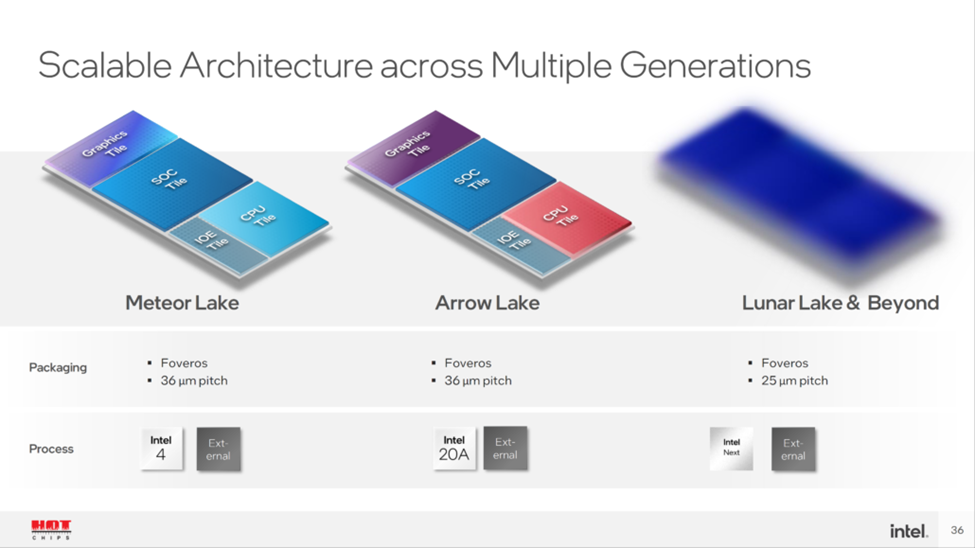Intel’s Lunar Lake CPUs are set to debut around 2024–2025, following Meteor Lake and Arrow Lake. The CPUs will feature separate CPU, GPU, and SoC tiles, with leaked information suggesting the GPU tile will use Intel’s next-gen Battlemage graphics with Xe2 cores. The Lunar Lake architecture is designed for ultra-thin laptops, targeting a TDP of 15W or below. The CPUs are expected to have up to eight cores, with four Lion Cove+ P-cores and four Skymont E-cores. The iGPU will have 64 Xe2 Execution Units and is anticipated to outperform current Intel mobile graphics. The tiled design allows Intel to address different application needs more effectively.
Intel’s upcoming Lunar Lake CPUs are expected to debut sometime in 2024 or H1 2025, following the Meteor Lake and Arrow Lake chips. These CPUs will incorporate separate CPU, GPU, and SoC tiles. Recent leaks suggest that the Lunar Lake’s GPU tile will feature Intel’s next-gen Battlemage graphics with Xe2 cores.

Intel actually revealed its plans for Lunar Lake at CES 2023 in January.
Hardware leaker Bionic_Squash has revealed specifications for Intel’s yet-to-launch Lunar Lake mobile platform. Lunar Lake is expected to arrive for the mobile segment after Arrow Lake. These CPUs will utilize the Battlemage Xe2 architecture for their integrated GPU.

Intel designed the Lunar Lake (LNL) architecture specifically for ultra-thin laptops, with a focus on maintaining performance while ensuring all-day battery life at a targeted TDP of 15W or below. It is anticipated that the Lunar Lake chips will use an Xe2-LPG iGPU based on the next-gen Battlemage architecture. More details about the Lunar Lake architecture have been leaked by Moore’s Law Is Dead (MLID) and Bionic_Squash.
Lunar Lake is scheduled for release in 2024 or 2025, built on the 18A process node. It is expected to feature the Lion Cove+ architecture for the P-cores and Skymont for the E-cores.
And according to Tom at MLID, the Lunar Lake CPUs are expected to have up to eight cores, consisting of four Lion Cove+ P-cores and four Skymont E-cores. The leaker refers to the LNL Lion Cove+ P-cores as an early implementation and mentions the absence of “working Rentable Units” that are expected in Arrow Lake chips.
The iGPU in Lunar Lake will be based on the Alchemist-next architecture code-named Battlemage, featuring a maximum of 64 Xe2 Execution Units (EUs), translating to four Xe-cores. However, Battlemage will move to SIMD-16, keeping the Xe-core count at eight, with each Xe-core containing eight vector engines (EUs), as opposed to 16 seen with Alchemist Arc.
MLID claims that the current Plan of Record for LNL chips suggests a GPU tile based on the Intel Arc Battlemage. Bionic_Squash reports on Twitter that the LNL iGPU will feature 64 Xe2 EUs and eight Xe2 cores, although the performance of these Xe2 cores remains unknown.
Considering the recent Arrow Lake performance leak, where the Xe-LPG featured in ARL-S CPUs was reported to be up to 2.4× faster than an Intel HD 770, it is expected that the Xe2-LPG iGPU inside LNL processors will significantly outperform the current Intel mobile graphics.
What do we think?
Employing a versatile tiled design will allow Intel to develop a diverse product family catering to various applications and requirements. For instance, Intel would typically have to create two completely separate silicon designs to meet the demands of customers seeking improved gaming performance and those prioritizing strong CPU capabilities. However, with a tiled approach, this process becomes more streamlined and manageable.